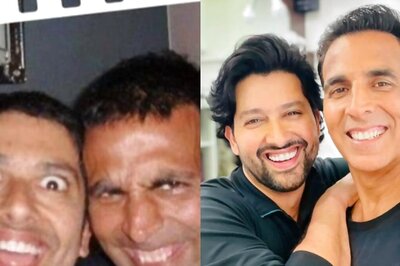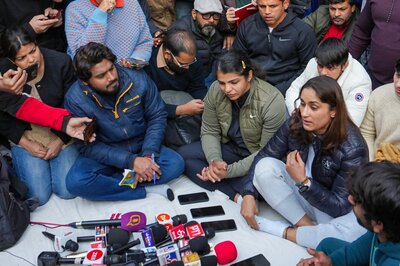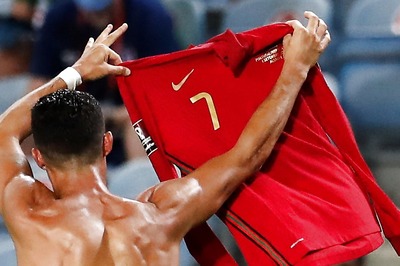
views
What does it mean when someone clasps their hands?
If their fingers are interlaced, they may be anxious. Holding hands with someone else is often seen as a soothing and comforting form of physical contact, and holding hands with yourself is no different. If someone is clasping their hands together with their fingers interlaced, it may be because they’re trying to self-soothe. This could be because they’re anxious, nervous, or upset. Body language cues: They’re fidgeting—leg tapping or bouncing. Their hands are likely clenched in their lap or in front of them. Their head may be low or hunched over their hands. Keep in mind: For many religions, interlacing the fingers while clasping the hands is a sign of prayer and submission to a higher power. Examples: You may see someone clasping their hands in this manner in a doctor’s waiting room, during a job interview, or before a stressful situation or conversation.
If their fingers aren’t interlaced, they're likely confident. A person clasping their hands with their fingers on either side of their palms (as if mid-clap) typically exudes confidence and pride. This position is usually used when displaying power or leadership. Body language cues: They stand tall with their shoulders back. Their arms were likely hanging by their sides before clasping their hands together. Their legs are uncrossed, showing they’re open for conversation or debate. Keep in mind: Some may clasp their hands this way behind their backs or in front of their chest. The position of the clasp doesn’t change the overall meaning, as the body is still left open and stoic as a sign of openness. Examples: You might see this hand position as someone gives a speech, teaches a class, or relays rules and regulations.
If the hands are clasped and wringing together, they’re distressed. Hand wringing is the act of repeatedly twisting or rubbing the hands together, often in a clasped position. This is a tell-tale sign of distress, anxiety, or nervousness. Psychologists believe the behavior soothes the individual, helping them organize and process their thoughts and feelings. Body language cues: Their shoulders are slumped, their head hangs low, and their overall posture is slouched or relaxed. Keep in mind: Hand wringing can also indicate other things. For instance, someone may do this while warming their hands in cold temperatures, which can also be distressing on the mind and body. Hand wringing is also a symptom of Rett syndrome, a rare genetic neurological and developmental disorder, and common in those with autism and OCD. Examples: You may see someone making this hand gesture before a big test, during a job interview, or when watching a horror movie.
If the hands are clasped near the face, they’re likely thinking. Movement around or near the throat hides the throat, and this is typically a sign of distress. Similarly, clasping the hands in front of the face shields the eyes and mouth, signaling the highest level of stress or discomfort. These hand gestures are most commonly used when thinking in or about stressful situations. Body language cues: They’re leaning toward their hands with their brows furrowed and eyes closed. They may rub their fingers over the back of their hands. Keep in mind: This position can also be an act of prayer, especially if the eyes are closed or the individual is kneeling. Examples: Someone may clasp their hands under their chin while thinking to self-soothe. You may also see someone clasping their hands in front of their face during an argument or while crying.
If the hands are clasped in front of the groin, they might be insecure. When someone holds their hands below their belt, it’s likely a sign that they’re feeling socially awkward. The closed-off nature of their body language indicates that they’re protecting themselves from potential judgment. Body language: Their arms are straight, they may shift their weight from foot to foot, and they avoid eye contact. Keep in mind: This position can also give off a sense of innocence or shyness. In other words, someone may clasp their hands in front of their groin because they simply don’t know what to do with their hands. Examples: You may see this hand position at a party or social gathering.
Does it matter which thumb goes on top?
It doesn’t matter which thumb goes on top. The thumb you place on top when clasping your hands is all hereditary! Believe it or not, which thumb feels the most comfortable on top is written in your genetics. After lots of myth-busting, scientists concluded that this preference has a genetic component, but it doesn’t influence a person’s character or personality. The original myth inferred that hand clasping is controlled by one gene with two alleles (with the left allele being dominant). If you put your right thumb over your left, you have a phenotype R. If you put your left over your right, you’re phenotype L.
How to Read Body Language
Pay attention to facial expressions. People can make subtle, subconscious changes to their facial features if they’re happy, sad, or somewhere in between. In many cases, you can convey what you’re feeling without even saying a word! So, when you’re talking to someone, keep an eye on their face and notice if they’re smiling, lifting their brows, or frowning. When someone’s surprised, they may raise and curve their brows, widen their eyes, and drop their jaw. When someone’s scared, they may draw their brows together, lower their eyes, and stretch their lips. When someone’s angry, they may lower their brows, lower their lips, jut out their jaw, and flare their nostrils. When someone’s happy, they may lift the corners of their mouth and squint their eyes. When someone’s sad, they may lower the corners of their mouth, furrow their brows, and pout their lips.
Keep an eye on eye contact. Eye contact can play a big part in nonverbal communication and body language. For many, whether or not they look someone in the eye can be telling of their mood. For instance, someone upset or angry might not be able to maintain eye contact for long periods of time, while someone calm and happy can. Be aware that reading eye contact isn’t foolproof. Poor eye contact can be a symptom of antisocial personality disorder, autism, and other behavioral disorders.
Look out for inconsistencies. People can fake their body language. There are many sources out there educating people on how to read body language (including this article). Because of this, someone could easily master altering their body language to appear confident or assert dominance. But they won’t be able to keep this up forever. Pay attention to inconsistencies in their stance, movements, and behavior. If someone’s telling the truth, you won’t question why they're acting a certain way. A prime example would be someone saying “yes” but shaking their head “no.”
Be aware of context clues. Sometimes, the easiest way to read someone’s body language is to look at their surroundings. What is the person wearing? What are they doing? Where are they? What’s the current situation? By asking yourself these questions, you can gather a better understanding of why they may be in a specific position. For instance, say you see a friend sitting outside the principal’s office with their hands clasped under their chin. Their knuckles are bruised. They’re rocking back and forth, muttering apologies. In this case, they’re probably nervous as they’ve likely been called to the principal’s office because they’ve gotten into a fight.
What does the clasped hands symbol mean?
The clasped hands symbol is a sign of unity. The image of two hands holding each other has been a strong symbol of hope and unity for centuries. More often than not, this powerful image can represent the merging or unification of different cultures, races, or opinions. The clasped hands symbol conveys the message, “We’re all in this together.”
The clasped hands symbol can be a final farewell. For centuries, the image of two hands clasped together has signified “goodbye” or farewell. It’s a good-natured symbol meant to unify and bring peace. You’ll commonly see this symbol on headstones or tombs to illustrate life and death or a loved one’s final goodbye.


















Comments
0 comment